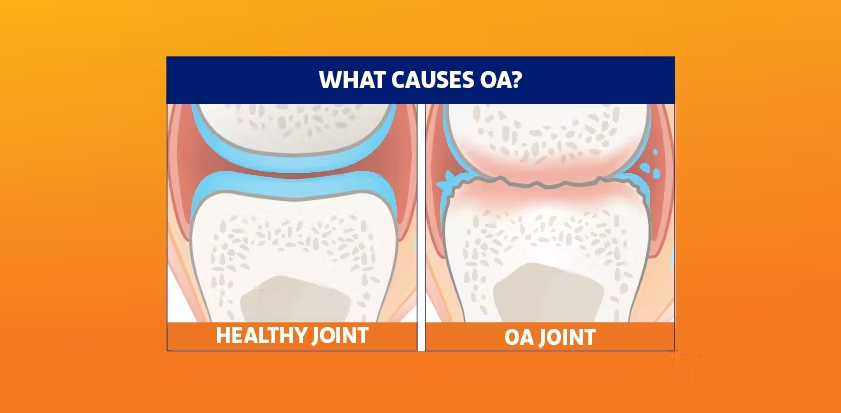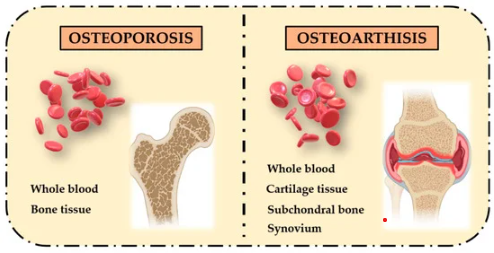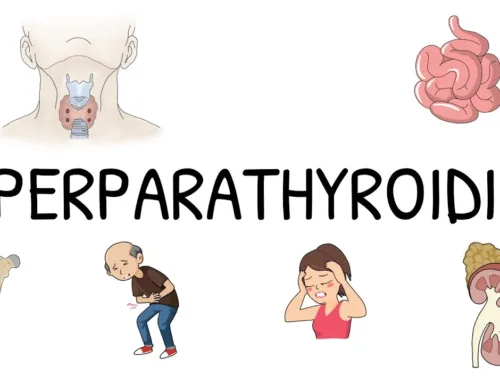
Source: Henry Ford Health
There is no denying that osteoporosis is a very common condition while osteoarthritis(OA) is a relatively uncommon one. Thus, any negative association between them would seem even more improbable. Nevertheless, according to recent studies, there indeed exists a relationship between the two conditions.
If you are having joint pain, it could be caused by osteoarthritis or osteoporosis. This can be confusing because the terms sound vaguely similar, but they have different meanings. Let us discover the relationship between osteoarthritis and osteoporosis to avoid confusion and misunderstandings.
What Is Osteoporosis?
Osteoporosis is a condition in which the bones become thin and brittle, causing them to break easily. The bone loss that occurs with osteoporosis makes bones susceptible to fractures, particularly hip, spine, and wrist fractures. Osteoporosis affects an estimated 10 million Americans, most of whom are women.

Source: CreakyJoints.org
Osteoporosis can lead to significant pain and disability. It is associated with a greater risk of death from any cause than any other disease or condition among both men and women in their 50s and 60s.
Osteoporosis is defined as low bone mass that leads to increased bone fragility and an increased risk of fracture. When doctors speak of osteoporosis, they are referring to both low bone mass and fragility. The terms “osteopenia” and “osteomalacia” refer only to low bone mass without increased fragility.
What Causes Osteoporosis?
Osteoporosis occurs when you lose more bone than your body makes or when your body doesn’t absorb enough calcium from your diet to meet its needs.

Source: Monib Health
Bone loss is a natural part of aging, but if you do not get enough calcium from food or supplements, you’re more likely to develop osteoporosis.
If you smoke cigarettes or drink too much alcohol regularly, you are also at greater risk of developing the disease. And if someone in your family has osteoporosis — especially if it runs in their female relatives — they are at a higher risk of developing osteoporosis.
What Is Osteoarthritis?
Osteoarthritis (OA) is the most common form of arthritis. It results when the protective cartilage that covers the ends of bones wears down over time. Cartilage acts as a shock absorber between joints, allowing your bones to glide smoothly against each other.

Source: Spine and Pain Clinics of North America
When the cartilage wears away, bone rubs directly against bone — causing pain, swelling, stiffness, and reduced range of motion.
Osteoarthritis affects people of all ages — including children and teens. But seniors are at higher risk for arthritis because as we age, our joints become more susceptible to injury and wear-and-tear.
Osteoarthritis most commonly affects joints in the hands, knees, and hips — but it can affect any joint in your body.
What Causes Osteoarthritis?
The cartilage is made up of cells called chondrocytes. These cells produce the protein collagen and other substances that keep your joints lubricated, healthy and stable. As you age, your body produces less of these lubricating substances, which can wear down the cartilage and cause osteoarthritis to develop. It is most common in people over 65 years old. The risk increases with age because the body becomes less efficient at repairing damage to cartilage over time.

Source: GSK Health Partner
Some people may be genetically predisposed to developing osteoarthritis because they have inherited a faulty gene that makes it harder for their body to repair damaged cartilage.
Moreover, excess weight puts more pressure on your joints and decreases their ability to move smoothly, which may lead to osteoarthritis over time.
Differences Between Osteoarthritis And Osteoporosis

Source: HCA Healthcare UK
| Osteoarthritis | Osteoporosis | |
|---|---|---|
| Causes | Osteoarthritis is a degenerative joint disease that occurs as a result of wear and tear of cartilage on the joints. The cause is not entirely known, but it has been linked to heredity, obesity, and injury. | Osteoporosis is caused by reduced bone mass, leading to fragile bones that fracture easily. This can happen due to a low intake of calcium and vitamin D or excessive use of alcohol. |
| Gender | Osteoarthritis affects both men and women after middle age. | Osteoporosis mostly affects older women after menopause due to decreased levels of estrogen causing bone loss. |
| Age | Osteoarthritis affects mostly older adults — especially those over 65 years old. However, it can occur at any age if you have an injury or medical condition that puts extra stress on your joints (such as rheumatoid arthritis). | Osteoporosis is not just for older adults. You can develop it at any age if you don’t get enough calcium and vitamin D in your diet or if you smoke cigarettes or drink excessive amounts of alcohol (which deplete your body’s vitamin reserves). |
| Ratio | Osteoarthritis is more common than osteoporosis, affecting approximately 27 million Americans, with 60 percent being women. | Osteoporosis is also common but not more than osteoarthritis. |
| Risk Factors | The risk factors for osteoarthritis include obesity, prior injuries or surgery, and genetics. | The risk factors for osteoporosis include low body weight and a family history of low bone density. |
| Symptoms | The main symptoms of osteoarthritis include pain and stiffness in the joints, loss of function, joint deformity, swelling, and early-stage joint destruction. | The main symptoms of osteoporosis experience bone pain, fractures, spinal curvature (kyphosis), and deformities in the body such as stooped posture or scoliosis due to weak bones. |
| Effects | Osteoarthritis affects the joints. | Osteoporosis affects the bones, making them less dense and weaker. |
| Treatments | The treatment for osteoarthritis differs depending on the severity of symptoms. Non-steroidal anti-inflammatory drugs (NSAIDs) such as ibuprofen may be prescribed to reduce inflammation and pain caused by the condition. In severe cases, surgery may be required to repair damaged joints or replace them with artificial ones. | For osteoporosis, medications such as bisphosphonates are prescribed to increase bone density and prevent further damage from occurring. |
| Avoiding Risk Factors | You can reduce your risk of osteoarthritis by maintaining a healthy weight, protecting your joints, and staying active. | You can reduce your risk of osteoporosis by maintaining a healthy weight, exercising regularly, and avoiding smoking and excessive alcohol use. |
Similarities Between Osteoarthritis And Osteoporosis

Source: MDPI
1. Both Conditions Involve Bones
Both osteoarthritis and osteoporosis involve changes in bone structure due to a lack of nutrients or inflammation caused by injuries or infections. These changes can lead to weakness in bone tissue and an increased risk for fractures or breaks in the future.
2. Age
Age is one of the first things that people think about when it comes to these two conditions. The majority of people who develop osteoarthritis or osteoporosis are over the age of 50. This is because the body begins to lose bone mass and strength as we age, making it more likely for bones to break or fracture.
3. Gender
Gender is another commonality between these two conditions. Men and women are equally affected by both osteoarthritis and osteoporosis, although there are some differences in how each gender experiences these diseases. For example, women tend to be diagnosed with osteoporosis at an earlier age than men do.
4. The Conditions Are Chronic
Both conditions are chronic, which means they do not go away on their own and need long-term treatment.
5. Both Can Be A Risk Factor For Each Other
Osteoarthritis can be a risk factor for developing osteoporosis because of its effect on bone health: The cartilage damage caused by the disease makes it harder for your body to absorb calcium from food sources, which can lead to bone loss over time if not treated properly. In addition, once your bones become weak from osteoporosis, it can make it more difficult for you to maintain good bone health.
6. Both Conditions Can Cause Pain
Both osteoarthritis and osteoporosis are characterized by joint pain. The pain is caused by the deterioration of the joints and surrounding tissues. The cause of this deterioration is unknown, but it can be attributed to aging, heredity, unbalanced nutrition, and lack of exercise.
7. Symptoms
There are several common symptoms associated with both diseases, including:
- Pain in your joints that worsens with activity.
- Stiffness when moving your joints (especially first thing in the morning).
- Swelling or warmth around the affected joints.
- A loss of range of motion (the ability to move your joints through their full range of motion).
8. Development And Progression
Each condition has risk factors that can speed up the development and progression of the disease.
Can You Have Both Conditions?
It sounds odd, but yes, you can have both conditions. Osteoarthritis and osteoporosis are two very different conditions that can affect the skeleton. However, they can both be present at the same time, which may make it difficult to diagnose and treat each condition separately.
The National Osteoporosis Foundation believes that osteoporosis can lead to an increased risk of developing osteoarthritis. In fact, about 50% of people with osteoporosis have a form of arthritis as well. But other experts believe that both conditions are separate from each other and should be treated separately.

Source: Quizlet
Osteoporosis is a disease in which your bones become weak, brittle, and more likely to break. Osteoarthritis is a degenerative joint disease characterized by joint pain and stiffness due to cartilage breakdown and damage. Both conditions are common in older adults.
When it comes to diagnosis, there are some similarities between the two conditions that make it difficult for doctors to know for sure if someone has osteoporosis or osteoarthritis. For example, both diseases can cause pain, swelling, and stiffness in the joints — making them hard to tell apart without testing. But there are also differences between the two diseases that can help doctors make a diagnosis.
Treatment Options Available For Osteoarthritis And Osteoporosis
Osteoarthritis and osteoporosis both have a broad range of treatment options. You may be able to reduce your pain and improve your quality of life with one or more of these treatments:
1. Non-Steroidal Anti-Inflammatory Drugs (NSAIDs)
These drugs can help relieve pain. They include aspirin, ibuprofen (Advil, Motrin IB, others), and naproxen sodium (Aleve). Side effects may include stomach upset, heartburn, and bleeding ulcers. NSAIDs should not be taken by people with certain medical conditions or who are taking other medications that increase the risk of bleeding or ulcers.
2. Acetaminophen (Tylenol)
This drug is another option for treating osteoarthritis pain. Acetaminophen has fewer side effects than NSAIDs but doesn’t work as well at relieving pain in some people. It is also safe for children over 2 years old and pregnant women at the recommended doses.

Source: Getty Images
3. Corticosteroid Injections
Corticosteroid injections can provide temporary relief from pain by reducing swelling in the affected joint. This can help patients to function better in their daily lives until more permanent treatments are available.
Things You Need To Take Care Of If You Have Osteoarthritis And Osteoporosis
Osteoarthritis and osteoporosis can lead to pain and disability. If you have both conditions or any of these conditions, it is important to treat them to prevent further damage.
Here are some things you need to take care of if you have osteoarthritis and osteoporosis:
1. Weight-Bearing Exercise Is Important For Both Conditions
Weight-bearing exercise helps strengthen your bones and muscles, so they can support your joints properly. It also helps improve the range of motion in affected joints. You should include weight-bearing exercises in your daily routine even if your arthritis causes joint pain.
2. Tailor Your Diet For Each Disease
Your diet affects your overall health, and it can also affect how well each condition responds to treatment. For example, studies suggest that eating high amounts of calcium may reduce the risk of developing osteoporosis but may increase the risk of developing kidney stones in people who already have osteoarthritis or other diseases that affect kidney function. So if you are at risk for both conditions, talk to your doctor about how the diet might affect them individually and together.
If you have osteoarthritis, you may need to reduce your sodium intake or avoid foods high in fat and sugar because they can make symptoms worse.
If you have osteoporosis, eating foods rich in calcium and vitamin D can help keep your bones strong and healthy. You should also limit how much caffeine you consume because it increases calcium loss in bones.

Source: Monib Health
3. Make Sure You Know The Facts About Both Conditions
Knowledge is power when it comes to understanding your condition, so learn all you can about osteoarthritis and osteoporosis. The more information you have about these two conditions, the better equipped you will be to manage them effectively.
4. Do Not Let People Tell You That There Is Nothing To Be Done About Either Condition
Many people believe that osteoarthritis cannot be treated or cured, but this is simply not true; there are effective treatments available for both osteoarthritis and osteoporosis today!
Conclusion & Takeaway
The bottom line is that osteoarthritis and osteoporosis definitely appear to be connected to some degree. In order to understand the relationship between osteoporosis and osteoarthritis, it is important to understand what each condition is, who is at risk for developing them, and the treatments.
If you want to prevent both conditions or at least delay the onset of symptoms, it’s important that you eat a healthy diet and stay in good physical shape by exercising regularly. While there is no guaranteed solution, these steps may help reduce the effect of arthritis and osteoporosis on your joints and bones.
If you think you might have osteoporosis or osteoarthritis, consult our endocrinologist at Houston Endocrine Center. Our doctors will help you diagnose the disease and provide the treatment that is best suited according to your condition. We offer the best services to our patients with osteoporosis or bone mineral disorders. We care for our people and value the health of every patient that reaches us.




Leave A Comment